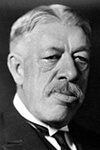Coley’s Toxins returning to forefront of immunotherapy
Chances are you have never heard of Coley's ToxinsA poison made by certain bacteria, plants, or animals, including insects.. However, scientists are reviving William Coley's methods to try different types of bacteria to encourage the immune system to fight tumors.
In 1891, Coley injected streptococcal organisms into a patient with inoperable cancer. Coley, a bone sarcoma surgeon, thought that the infection he produced would have the side effect of shrinking the malignant tumor. He was successful — and this was one of the first examples of immunotherapy.
During the next 40 years, as head of the Bone Tumor Service at Memorial Hospital in New York, Coley injected more than 1,000 cancer patients with bacteria or bacterial products. These products became known as Coley's Toxins. He and other doctors who used them reported excellent results, especially in bone and soft-tissue sarcomas.

Despite his reported good results, Coley's Toxins came under a great deal of criticism; many doctors did not believe his results. This criticism, along with the development of radiation therapy and chemotherapy, caused Coley's Toxins to gradually disappear from use.
“Those who have scrutinized Coley’s results have little doubt that these bacterial toxins were highly effective in some cases,” said Dr. Lloyd J. Old, former associate director of Memorial Sloan Kettering, and also the Cancer Research Institute’s medical director from 1971-2011.
However, the modern science of immunology has shown that Coley's principles were correct and that some cancers are sensitive to an enhanced immune system.
In 2014, scientists injected innocuous strains of C. novyi bacteria into 16 dogs who had soft-tissue sarcomas and even one person with a rare type of cancer. The bacteria shrank the size of the tumors; in a few of the animals, the tumors completely disappeared. [1]
In 2015, scientists modified a strain of salmonella to attack tumors in mice. [2]
Not only is Coley known as the “Father of Immunotherapy,” he also became the model for the present-day clinician-scientist. Born in 1862, Coley went to Yale and graduated from Harvard Medical School in 1888.

“Those who have scrutinized Coley’s results have little doubt that these bacterial toxins were highly effective in some cases.”
Dr. Lloyd J. Old
Memorial Sloan Kettering
He was dismissed by the scientific community because his methods of treatment and patient follow-up were not consistent, and many colleagues could not believe his good results. Again, in light of recent discoveries in immunology, some of his observations were correct — and his theories may have much to offer today.
Now, 126 years after Coley's Toxins made its mark, scientists are using salmonella in immunotherapy research. A study, Two-step enhanced cancer immunotherapy with engineered Salmonella typhimurium secreting heterologous flagellin, was published in Science Translational Medicine, in which mice were injected with a strain of engineered salmonella that infiltrated the tumors. [3]
Salmonella thrives in environments with no oxygen, and tumors have no oxygen and a lot of dead cells the bacteria can feed on. The tumor is “a very favorable home for salmonella,” said Roy Curtiss III, a professor at the University of Florida’s College of Veterinary Medicine, who also has studied the use of salmonella as a cancer therapy. “It’s a good food supply.”
The tumor is “a very favorable home for salmonella,” Roy Curtiss III, a professor at the University of Florida’s College of Veterinary Medicine, told The Verge. Curtiss also has studied the use of salmonella as a cancer therapy. “It’s a good food supply.”
“It shows that what was done 120 years ago with Coley’s Toxins deserves to be revisited again today, using bacteria as an adjuvant to stimulate the immune system to fight cancer,” Saha said. “I think it’s a very important modality, and one that we should continue pressing forward on to learn more about.”
References
- Roberts, N. J. et al. “Intratumoral Injection Of Clostridium Novyi-NT Spores Induces Antitumor Responses”. Science Translational Medicine 6.249 (2014): 249ra111-249ra111. Web. 9 Feb. 2017.
- Frahm, Michael et al. “Efficiency Of Conditionally Attenuatedsalmonella Entericaserovar Typhimurium In Bacterium-Mediated Tumor Therapy”. mBio 6.2 (2015): e00254-15. Web. 9 Feb. 2017.
- Zheng, Jin Hai et al. “Two-Step Enhanced Cancer Immunotherapy With Engineered Salmonella Typhimurium Secreting Heterologous Flagellin”. Science Translational Medicine 9.376 (2017): eaak9537. Web. 9 Feb. 2017.
